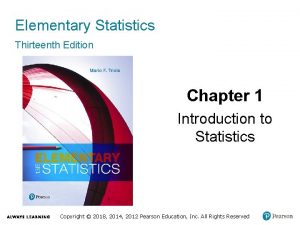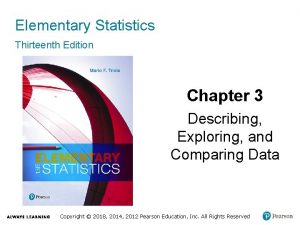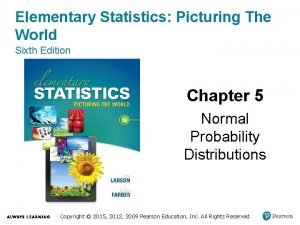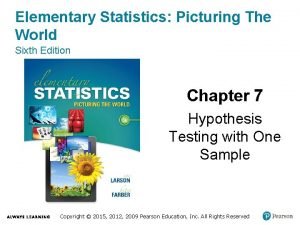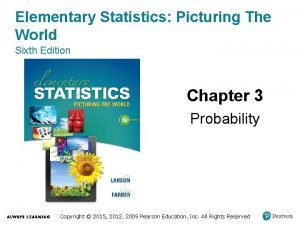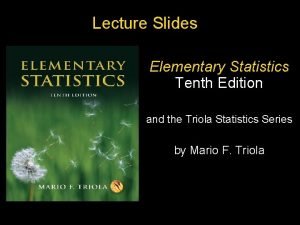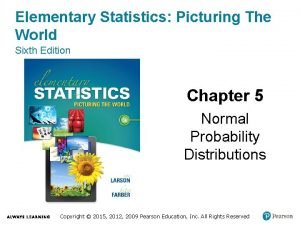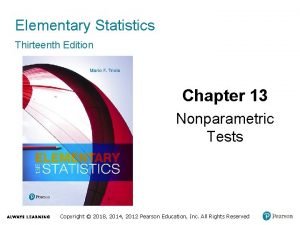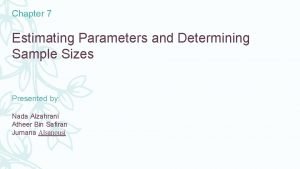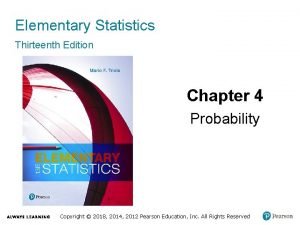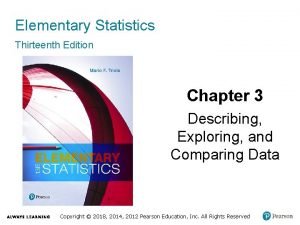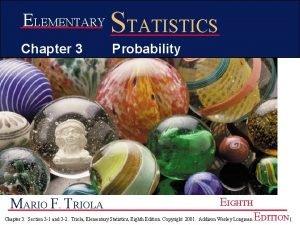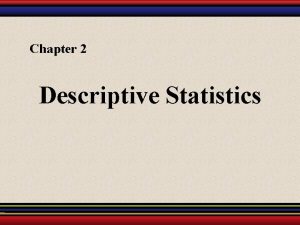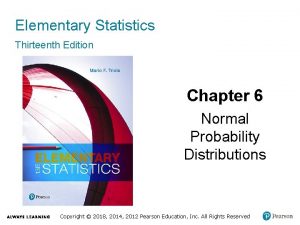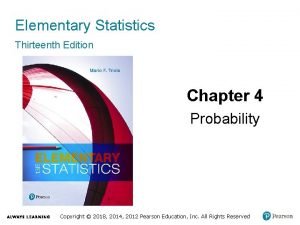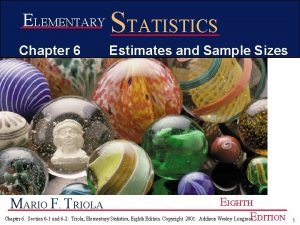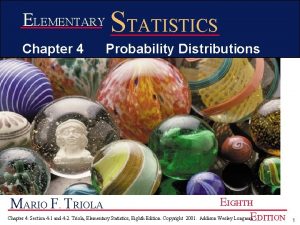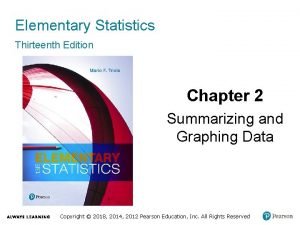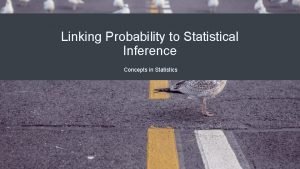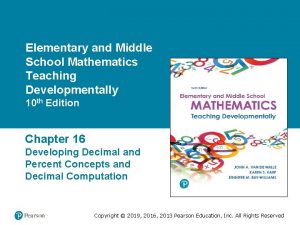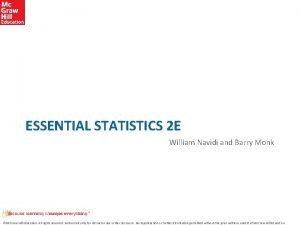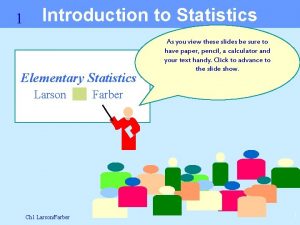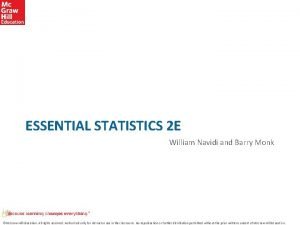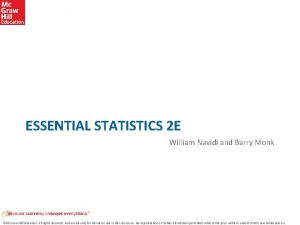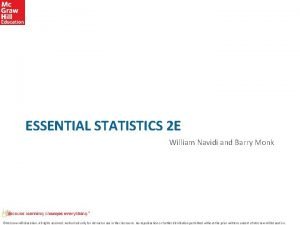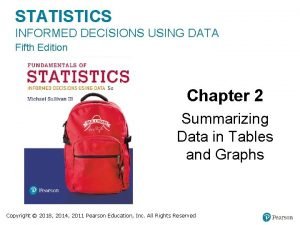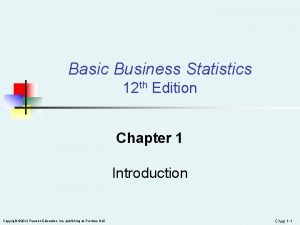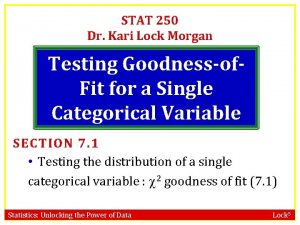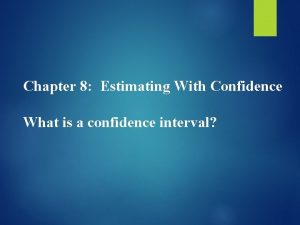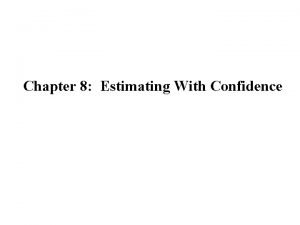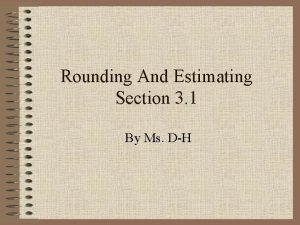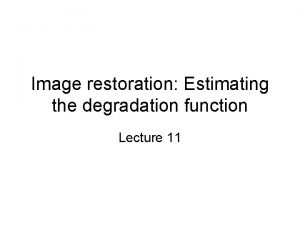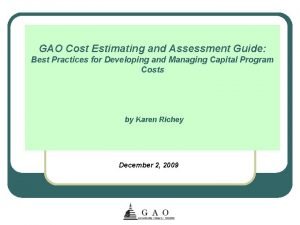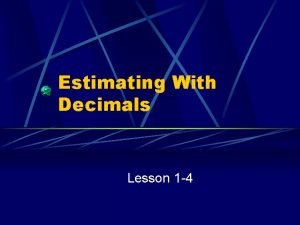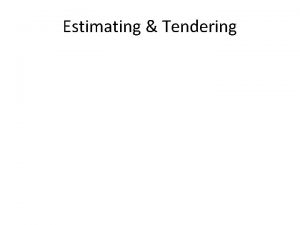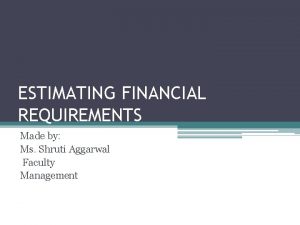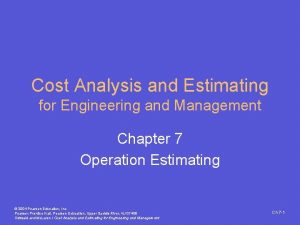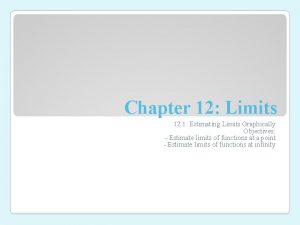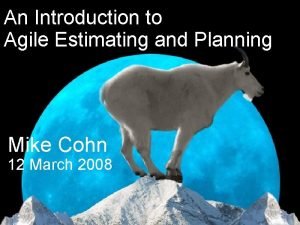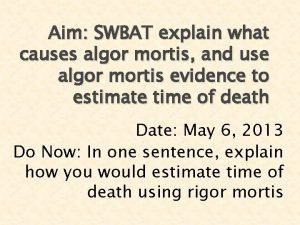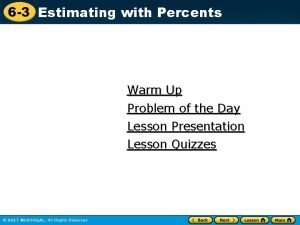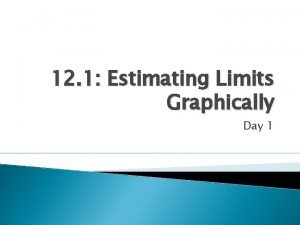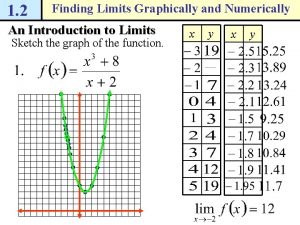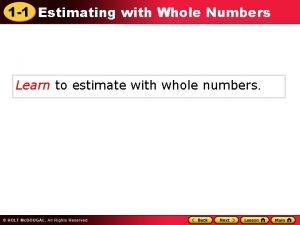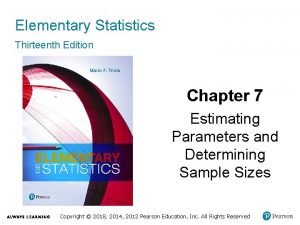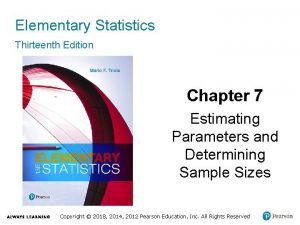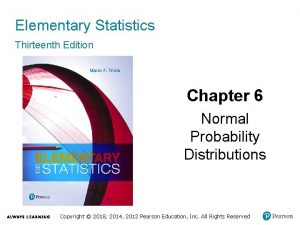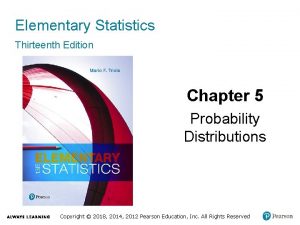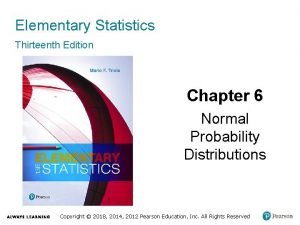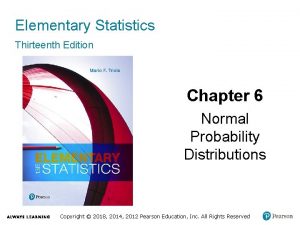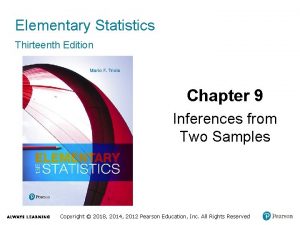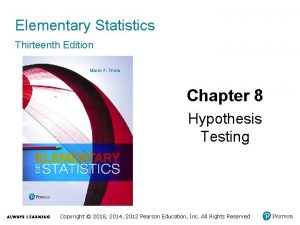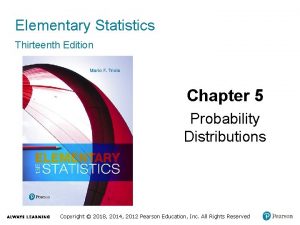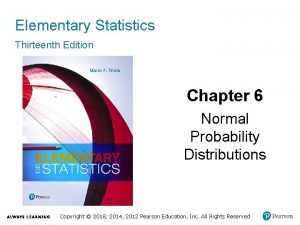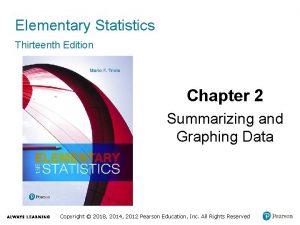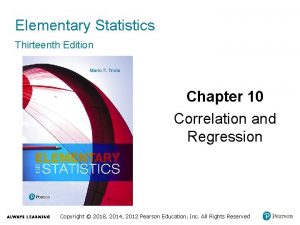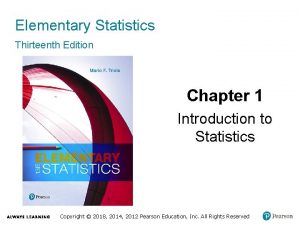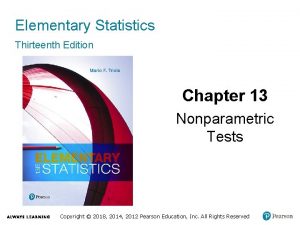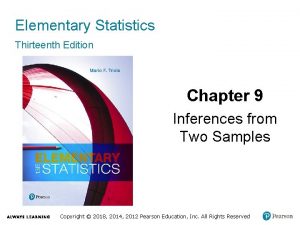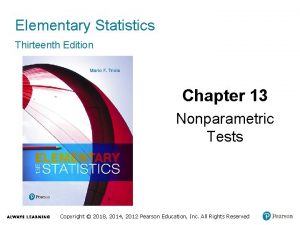Elementary Statistics Thirteenth Edition Chapter 7 Estimating Parameters






















































- Slides: 54

Elementary Statistics Thirteenth Edition Chapter 7 Estimating Parameters and Determining Sample Sizes Copyright © 2018, 2014, 2012 Pearson Education, Inc. All Rights Reserved

Estimating Parameters and Determining Sample Sizes 7− 1 Estimating a Population Proportion 7− 2 Estimating a Population Mean 7− 3 Estimating a Population Standard Deviation or Variance 7− 4 Bootstrapping: Using Technology for Estimates Copyright © 2018, 2014, 2012 Pearson Education, Inc. All Rights Reserved

Key Concept This section presents methods for using a sample proportion to make an inference about the value of the corresponding population proportion. Here are three main concepts included in this section: • Confidence Interval: We can use a sample proportion to construct a confidence interval estimate of the true value of a population proportion. • Sample Size: We should know how to find the sample size necessary to estimate a population proportion. Copyright © 2018, 2014, 2012 Pearson Education, Inc. All Rights Reserved

Point Estimate (1 of 2) • Point Estimate Copyright © 2018, 2014, 2012 Pearson Education, Inc. All Rights Reserved

Point Estimate (2 of 2) An unbiased estimator is a statistic that targets the value of the corresponding population parameter in the sense that the sampling distribution of the statistic has a mean that is equal to the corresponding population parameter. Copyright © 2018, 2014, 2012 Pearson Education, Inc. All Rights Reserved

Example: Facebook (1 of 2) A Gallup poll was taken in which 1487 adults were surveyed and 43% of them said that they have a Facebook page. Based on that result, find the best point estimate of the proportion of all adults who have a Facebook page. Copyright © 2018, 2014, 2012 Pearson Education, Inc. All Rights Reserved

Example: Facebook (2 of 2) Solution Because the sample proportion is the best point estimate of the population proportion, we conclude that the best point estimate of p is 0. 43. (If using the sample results to estimate the percentage of all adults who have a Facebook page, the best point estimate is 43%. ) Copyright © 2018, 2014, 2012 Pearson Education, Inc. All Rights Reserved

Confidence Interval • Confidence Interval – A confidence interval (or interval estimate) is a range (or an interval) of values used to estimate the true value of a population parameter. A confidence interval is sometimes abbreviated as CI. Copyright © 2018, 2014, 2012 Pearson Education, Inc. All Rights Reserved

Confidence Level • Confidence Level – The confidence level is the probability 1 − α (such as 0. 95, or 95%) that the confidence interval actually does contain the population parameter, assuming that the estimation process is repeated a large number of times. (The confidence level is also called the degree of confidence, or the confidence coefficient. ) Copyright © 2018, 2014, 2012 Pearson Education, Inc. All Rights Reserved

Relationship Between Confidence Level and α The following table shows the relationship between the confidence level and the corresponding value of α. The confidence level of 95% is the value used most often. Most Common Confidence Levels Corresponding Values of α 90% (or 0. 90) confidence level: α = 0. 10 95% (or 0. 95) confidence level: α = 0. 05 99% (or 0. 99) confidence level: α = 0. 01 Copyright © 2018, 2014, 2012 Pearson Education, Inc. All Rights Reserved

Interpreting a Confidence Interval (1 of 3) We must be careful to interpret confidence intervals correctly. There is a correct interpretation and many different and creative incorrect interpretations of the confidence interval 0. 405 < p < 0. 455. Correct: “We are 95% confident that the interval from 0. 405 to 0. 455 actually does contain the true value of the population proportion p. ” Copyright © 2018, 2014, 2012 Pearson Education, Inc. All Rights Reserved

Interpreting a Confidence Interval (2 of 3) We must be careful to interpret confidence intervals correctly. There is a correct interpretation and many different and creative incorrect interpretations of the confidence interval 0. 405 < p < 0. 455. Wrong: “There is a 95% chance that the true value of p will fall between 0. 405 and 0. 455. ” Copyright © 2018, 2014, 2012 Pearson Education, Inc. All Rights Reserved

Interpreting a Confidence Interval (3 of 3) We must be careful to interpret confidence intervals correctly. There is a correct interpretation and many different and creative incorrect interpretations of the confidence interval 0. 405 < p < 0. 455. Wrong: “ 95% of sample proportions will fall between 0. 405 and 0. 455. ” Copyright © 2018, 2014, 2012 Pearson Education, Inc. All Rights Reserved

The Process Success Rate A confidence level of 95% tells us that the process we are using should, in the long run, result in confidence interval limits that contain the true population proportion 95% of the time. Confidence Interval from 20 Different Samples Copyright © 2018, 2014, 2012 Pearson Education, Inc. All Rights Reserved

Critical Values • Critical Values – A critical value is the number on the borderline separating sample statistics that are significantly high or low from those that are not significant. Copyright © 2018, 2014, 2012 Pearson Education, Inc. All Rights Reserved

Example: Finding a Critical Value (1 of 3) Copyright © 2018, 2014, 2012 Pearson Education, Inc. All Rights Reserved

Example: Finding a Critical Value (2 of 3) Solution Copyright © 2018, 2014, 2012 Pearson Education, Inc. All Rights Reserved

Example: Finding a Critical Value (3 of 3) Note that when finding the critical z score for a 95% confidence level, we use a cumulative left area of 0. 9750 (not 0. 95). Think of it this way: Copyright © 2018, 2014, 2012 Pearson Education, Inc. All Rights Reserved

Common Critical Values This is the most common critical value, and it is listed with two other common values in the table that follows. Copyright © 2018, 2014, 2012 Pearson Education, Inc. All Rights Reserved

Margin of Error The margin of error E is also called the maximum error of the estimate and can be found by multiplying the critical value and the estimated standard deviation of sample proportions. Copyright © 2018, 2014, 2012 Pearson Education, Inc. All Rights Reserved

Margin of Error for Proportions Formula Copyright © 2018, 2014, 2012 Pearson Education, Inc. All Rights Reserved

Confidence Interval for Estimating a Population Proportion p: Objective Construct a confidence interval used to estimate a population proportion p. Copyright © 2018, 2014, 2012 Pearson Education, Inc. All Rights Reserved

Confidence Interval for Estimating a Population Proportion p: Notation Copyright © 2018, 2014, 2012 Pearson Education, Inc. All Rights Reserved

Confidence Interval for Estimating a Population Proportion p: Requirements 1. The sample is a simple random sample. 2. The conditions for the binomial distribution are satisfied: There is a fixed number of trials, the trials are independent, there are two categories of outcomes, and the probabilities remain constant for each trial. 3. There at least 5 successes and at least 5 failures. Copyright © 2018, 2014, 2012 Pearson Education, Inc. All Rights Reserved

Confidence Interval for Estimating a Population Proportion p: Confidence Interval Estimate of p The confidence interval is often expressed in the following formats: Copyright © 2018, 2014, 2012 Pearson Education, Inc. All Rights Reserved

Confidence Interval for Estimating a Population Proportion p: Round−Off Rule for Confidence Interval Estimates of p Round the confidence interval limits for p to three significant digits. Copyright © 2018, 2014, 2012 Pearson Education, Inc. All Rights Reserved

Procedure for Constructing a Confidence Interval for p (1 of 2) 1. Verify that the requirements in the preceding slides are satisfied. Copyright © 2018, 2014, 2012 Pearson Education, Inc. All Rights Reserved

Procedure for Constructing a Confidence Interval for p (2 of 2) 5. Round the resulting confidence interval limits to three significant digits. Copyright © 2018, 2014, 2012 Pearson Education, Inc. All Rights Reserved

Example: Constructing a Confidence Interval: Poll Results (1 of 8) We noted that a Gallup poll of 1487 adults showed that 43% of the respondents have Facebook pages. a. Find the margin of error E that corresponds to a 95% confidence level. b. Find the 95% confidence interval estimate of the population proportion p. c. Based on the results, can we safely conclude that fewer than 50% of adults have Facebook pages? Assuming that you are a newspaper reporter, write a brief statement that accurately describes the results and includes all of the relevant information. Copyright © 2018, 2014, 2012 Pearson Education, Inc. All Rights Reserved

Example: Constructing a Confidence Interval: Poll Results (2 of 8) Requirement Check (1) The polling methods used by the Gallup organization result in samples that can be considered to be simple random samples. (2) The conditions for a binomial experiment are satisfied because there is a fixed number of trials (1487), the trials are independent (because the response from one person doesn’t affect the probability of the response from another person), there are two categories of outcome (subject has a Facebook page or does not), and the probability remains constant, because P(having a Facebook page) is fixed for a given point in time. (3) With 43% of the respondents having Facebook pages, the number with Facebook pages is 639 (or 43% of 1487). If 639 of the 1487 subjects have Facebook pages, the other 848 do not, so the number of successes (639) and the number of failures (848) are both at least 5. The check of requirements has been successfully completed. Copyright © 2018, 2014, 2012 Pearson Education, Inc. All Rights Reserved

Example: Constructing a Confidence Interval: Poll Results (3 of 8) Technology The confidence interval and margin of error can be easily found using technology. From the Statdisk display on the next slide, we can see the required entries on the left and the results displayed on the right. Like most technologies, Statdisk requires a value for the number of successes, so we simply find 43% of 1487 and round the result of 639. 41 to the whole number 639. The results show that the margin of error is E = 0. 025 (rounded) and the confidence interval is 0. 405 < p < 0. 455 (rounded). Copyright © 2018, 2014, 2012 Pearson Education, Inc. All Rights Reserved

Example: Constructing a Confidence Interval: Poll Results (4 of 8) Technology Copyright © 2018, 2014, 2012 Pearson Education, Inc. All Rights Reserved

Example: Constructing a Confidence Interval: Poll Results (5 of 8) Solution (Manual Calculation) Copyright © 2018, 2014, 2012 Pearson Education, Inc. All Rights Reserved

Example: Constructing a Confidence Interval: Poll Results (6 of 8) Solution 0. 43 − 0. 0251636 < p < 0. 43 + 0. 0251636 0. 405 < p < 0. 455 (rounded) Copyright © 2018, 2014, 2012 Pearson Education, Inc. All Rights Reserved

Example: Constructing a Confidence Interval: Poll Results (7 of 8) Solution c. Based on the confidence interval obtained in part (b), it does appear that fewer than 50% of adults have a Facebook page because the interval of values from 0. 405 to 0. 455 is an interval that is completely below 0. 50. Copyright © 2018, 2014, 2012 Pearson Education, Inc. All Rights Reserved

Example: Constructing a Confidence Interval: Poll Results (8 of 8) Summary of results Here is one statement that summarizes the results: 43% of adults have Facebook pages. That percentage is based on a Gallup poll of 1487 randomly selected adults in the United States. In theory, in 95% of such polls, the percentage should differ by no more than 2. 5 percentage points in either direction from the percentage that would be found by interviewing all adults. Copyright © 2018, 2014, 2012 Pearson Education, Inc. All Rights Reserved

Analyzing Polls When analyzing results from polls, consider the following: 1. The sample should be a simple random sample, not an inappropriate sample. 2. The confidence level should be provided. 3. The sample size should be provided. 4. Except for relatively rare cases, the quality of the poll results depends on the sampling method and the size of the sample, but the size of the population is usually not a factor. Copyright © 2018, 2014, 2012 Pearson Education, Inc. All Rights Reserved

Caution Never think that poll results are unreliable if the sample size is a small percentage of the population size. The population size is usually not a factor in determining the reliability of a poll. Copyright © 2018, 2014, 2012 Pearson Education, Inc. All Rights Reserved

Finding the Point Estimate and E from a Confidence Interval Point estimate of p: Margin of error: Copyright © 2018, 2014, 2012 Pearson Education, Inc. All Rights Reserved

Example: Finding a Sample Proportion and Margin of Error (1 of 3) • Copyright © 2018, 2014, 2012 Pearson Education, Inc. All Rights Reserved

Example: Finding a Sample Proportion and Margin of Error (2 of 3) Solution We get the 95% confidence interval of 0. 58 < p < 0. 81 from the given statement of “ 58% to 81%. ” Copyright © 2018, 2014, 2012 Pearson Education, Inc. All Rights Reserved

Example: Finding a Sample Proportion and Margin of Error (3 of 3) Solution The margin of error can be found as follows: Copyright © 2018, 2014, 2012 Pearson Education, Inc. All Rights Reserved

Determining Sample Size: Finding the Sample Size Required to Estimate a Population Proportion: Objective Finding the Sample Size Required to Estimate a Population Proportion Copyright © 2018, 2014, 2012 Pearson Education, Inc. All Rights Reserved

Determining Sample Size: Finding the Sample Size Required to Estimate a Population Proportion: Notation Copyright © 2018, 2014, 2012 Pearson Education, Inc. All Rights Reserved

Determining Sample Size: Finding the Sample Size Required to Estimate a Population Proportion: Requirements The sample must be a simple random sample of independent sample units. Copyright © 2018, 2014, 2012 Pearson Education, Inc. All Rights Reserved

Determining Sample Size: Finding the Sample Size Required to Estimate a Population Proportion: Round−Off Rule for Determining Sample Size If the computed sample size n is not a whole number, round the value of n up to the next larger whole number, so the sample size is sufficient instead of being slightly insufficient. For example, round 1067. 11 to 1068. Copyright © 2018, 2014, 2012 Pearson Education, Inc. All Rights Reserved

Example: What Percentage of Adults Make Online Purchases? (1 of 4) When the author was conducting research for this chapter, he could find no information about the percentage of adults who make online purchases, yet that information is extremely important to online stores as well as brick and mortar stores. If the author were to conduct his own survey, how many adults must be surveyed in order to be 95% confident that the sample percentage is in error by no more than three percentage points? a. Assume that a recent poll showed that 80% of adults make online purchases. b. Assume that we have no prior information suggesting a possible value of the population proportion. Copyright © 2018, 2014, 2012 Pearson Education, Inc. All Rights Reserved

Example: What Percentage of Adults Make Online Purchases? (2 of 4) Solution a. We must obtain a simple random sample that includes at least 683 adults. Copyright © 2018, 2014, 2012 Pearson Education, Inc. All Rights Reserved

Example: What Percentage of Adults Make Online Purchases? (3 of 4) Solution b. With no prior knowledge of pn (or qn), we use Formula 7− 3 as follows: We must obtain a simple random sample that includes at least 1068 adults. Copyright © 2018, 2014, 2012 Pearson Education, Inc. All Rights Reserved

Example: What Percentage of Adults Make Online Purchases? (4 of 4) Interpretation To be 95% confident that our sample percentage is within three percentage points of the true percentage for all adults, we should obtain a simple random sample of 1068 adults, assuming no prior knowledge. By comparing this result to the sample size of 683 found in part (a), we can see that if we have no knowledge of a prior study, a larger sample is required to achieve the Copyright © 2018, 2014, 2012 Pearson Education, Inc. All Rights Reserved

Better Performing Confidence Intervals (1 of 3) Plus Four Method The plus four confidence interval performs better than the Wald confidence interval in the sense that its coverage probability is closer to the confidence level that is used. The plus four confidence interval uses this very simple procedure: Add 2 to the number of successes x, add 2 to the number of failures (so that the number of trials n is increased by 4), and then find the Wald confidence interval as described in Part 1 of this section. Copyright © 2018, 2014, 2012 Pearson Education, Inc. All Rights Reserved

Better Performing Confidence Intervals (2 of 3) Wilson Score The Wilson score confidence interval performs better than the Wald CI in the sense that the coverage probability is closer to the confidence level. With a confidence level of 95%, the Wilson score confidence interval would get us closer to a 0. 95 probability of containing the parameter p. However, given its complexity, it is easy to see why this superior Wilson score confidence interval is not used much in introductory statistics courses. Copyright © 2018, 2014, 2012 Pearson Education, Inc. All Rights Reserved

Better Performing Confidence Intervals (3 of 3) Clopper−Pearson Method The Clopper−Pearson method is an “exact” method in the sense that it is based on the exact binomial distribution instead of an approximation of a distribution. It is criticized for being too conservative in this sense: When we select a specific confidence level, the coverage probability is usually greater than or equal to the selected confidence level. Select a confidence level of 0. 95, and the actual coverage probability is usually 0. 95 or greater, so that 95% or more of such confidence intervals will contain p. Calculations with this method are too messy to consider here. Copyright © 2018, 2014, 2012 Pearson Education, Inc. All Rights Reserved

Which Method is Best? There are other methods for constructing confidence intervals that are not discussed here. There isn’t universal agreement on which method is best for constructing a confidence interval estimate of p. • The Wald confidence interval is best as a teaching tool for introducing students to confidence intervals. • The plus four confidence interval is almost as easy as Wald and it performs better than Wald by having a coverage probability closer to the selected confidence level. Copyright © 2018, 2014, 2012 Pearson Education, Inc. All Rights Reserved
 Elementary statistics 13th edition chapter 1
Elementary statistics 13th edition chapter 1 Elementary statistics 13th edition answers
Elementary statistics 13th edition answers Picturing distributions with graphs
Picturing distributions with graphs Elementary statistics 6th edition
Elementary statistics 6th edition Elementary statistics picturing the world 6th edition
Elementary statistics picturing the world 6th edition Elementary statistics tenth edition
Elementary statistics tenth edition Elementary statistics picturing the world 6th edition
Elementary statistics picturing the world 6th edition Elementary statistics 13th edition
Elementary statistics 13th edition What is the point estimate of μ?
What is the point estimate of μ? 5 guideline for cumbersome calculations
5 guideline for cumbersome calculations Elementary statistics chapter 3
Elementary statistics chapter 3 Elementary statistics chapter 3 answers
Elementary statistics chapter 3 answers Elementary statistics larson farber
Elementary statistics larson farber Elementary statistics chapter 6
Elementary statistics chapter 6 Elementary statistics chapter 4
Elementary statistics chapter 4 Margin of error statistics
Margin of error statistics Elementary statistics chapter 4
Elementary statistics chapter 4 Elementary statistics chapter 2
Elementary statistics chapter 2 Inferences in statistics
Inferences in statistics Elementary and middle school mathematics 10th edition
Elementary and middle school mathematics 10th edition Essential statistics william navidi pdf
Essential statistics william navidi pdf Introduction to elementary statistics
Introduction to elementary statistics Essential statistics william navidi pdf
Essential statistics william navidi pdf William navidi essential statistics pdf
William navidi essential statistics pdf William navidi elementary statistics pdf
William navidi elementary statistics pdf Mis chapter 6
Mis chapter 6 Using mis (10th edition)
Using mis (10th edition) Statistics informed decisions using data 5th edition pdf
Statistics informed decisions using data 5th edition pdf Basic business statistics 12th edition
Basic business statistics 12th edition Statistics: unlocking the power of data 1st edition
Statistics: unlocking the power of data 1st edition Joey's first 14 quiz grades in a marking period were
Joey's first 14 quiz grades in a marking period were Introduction to statistics what is statistics
Introduction to statistics what is statistics Chapter 8 estimating with confidence
Chapter 8 estimating with confidence Suppose your class is investigating the weights of snickers
Suppose your class is investigating the weights of snickers Chapter 8 estimating with confidence
Chapter 8 estimating with confidence Types of information systems
Types of information systems Rounding and estimating
Rounding and estimating Usace cost estimating software
Usace cost estimating software Estimating the degradation function
Estimating the degradation function Ground rules earthwork estimating software
Ground rules earthwork estimating software Estimating decimals
Estimating decimals Tendering and estimating
Tendering and estimating Shruti sheladia
Shruti sheladia Estimating earthwork
Estimating earthwork Concrete construction estimating
Concrete construction estimating Estimating avogadro's number lab
Estimating avogadro's number lab Cleat wiring system
Cleat wiring system Cost analysis and estimating for engineering and management
Cost analysis and estimating for engineering and management 12-1 estimating limits graphically
12-1 estimating limits graphically Agile estimating and planning
Agile estimating and planning Algor mortis worksheet
Algor mortis worksheet Estimating with percents
Estimating with percents Finding limits graphically and numerically worksheet
Finding limits graphically and numerically worksheet Lesson 2 understanding limits graphically and numerically
Lesson 2 understanding limits graphically and numerically How to estimate whole numbers
How to estimate whole numbers
